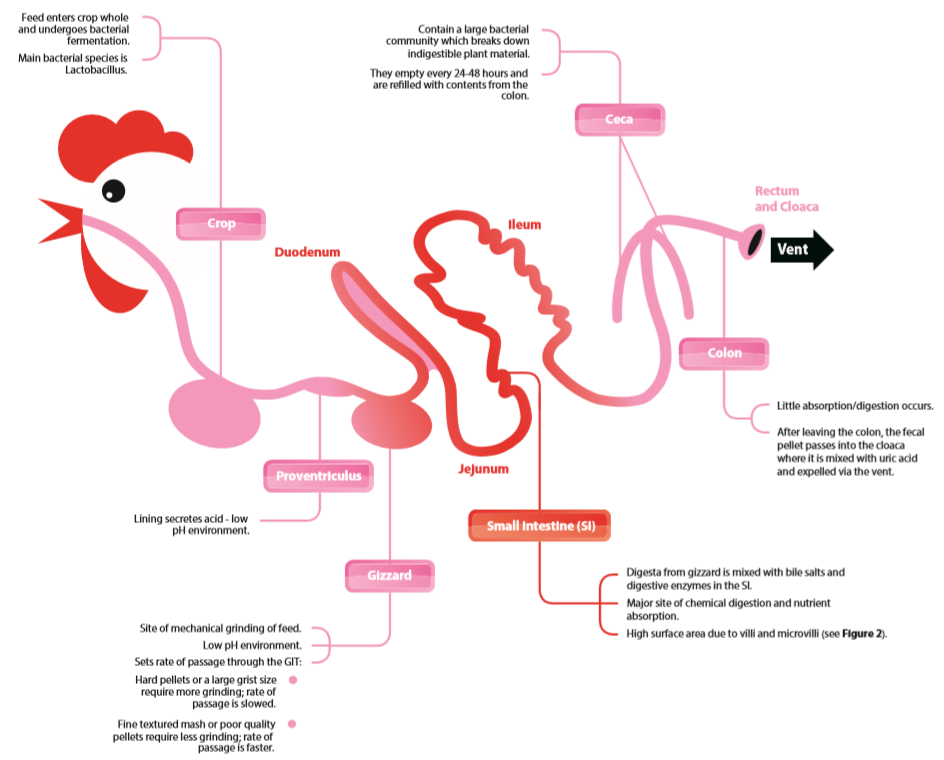The digestion, metabolism, and absorption of nutrients in broilers (young chickens raised for meat production) are complex processes essential for growth, development, and overall health. Here’s an overview of how these processes occur in broilers:
1. Digestion:
Mouth: The digestion process begins with mechanical breakdown as broilers peck, tear, and grind feed particles. Salivary enzymes initiate the digestion of carbohydrates.
Stomach (Proventriculus): Secretion of gastric juices containing enzymes (e.g., pepsin) starts the breakdown of proteins.
Gizzard: Powerful muscular organ that grinds and further breaks down feed particles. It acts as a mechanical aid to digestion.
Small Intestine (Duodenum, Jejunum, Ileum): The majority of nutrient digestion and absorption occurs in the small intestine. Pancreatic enzymes (lipase, amylase, protease) and bile from the liver aid in the breakdown of lipids, carbohydrates, and proteins.
2. Absorption:
Villi and Microvilli: The lining of the small intestine contains finger-like projections called villi, which further have microvilli. These structures increase the surface area for nutrient absorption.
Nutrient Uptake:
Carbohydrates: Broken down into simple sugars (glucose, fructose) and absorbed.
Proteins: Digested into amino acids and absorbed.
Fats: Broken down into fatty acids and glycerol and then absorbed.
Mineral and Vitamin Absorption:
Minerals: Absorbed through active or passive transport mechanisms.
Vitamins: Absorbed through passive diffusion or carrier-mediated processes.
Water and Electrolyte Absorption:
Active Processes: Absorption of sodium, chloride, and other electrolytes.
Passive Processes: Water absorption follows the movement of electrolytes.
3. Metabolism:
Liver: Acts as a central metabolic organ. It processes absorbed nutrients and regulates their distribution.
Glycolysis: Breaks down glucose to produce energy (ATP).
Gluconeogenesis: Synthesizes glucose from non-carbohydrate sources.
Fatty Acid Synthesis: Converts excess glucose into fatty acids for storage.
Energy Metabolism:
Aerobic Respiration: Utilizes oxygen to produce energy efficiently.
Anaerobic Respiration: Occurs in the absence of oxygen, producing less energy and lactic acid.
Protein Metabolism:
Protein Synthesis: Amino acids are used to build proteins for growth and tissue repair.
Protein Catabolism: Breakdown of proteins to release amino acids for energy or conversion to other compounds.
Fat Metabolism:
Lipolysis: Breaks down fats into fatty acids and glycerol for energy.
Ketogenesis: Formation of ketone bodies from fatty acids during periods of low carbohydrate availability.
4. Excretion:
Waste Products: Metabolic by-products, such as carbon dioxide, urea, and ammonia, are excreted through respiration, urine, and manure.
5. Growth:
Nutrient Utilization: Nutrients absorbed and metabolized contribute to body growth, muscle development, and overall maturation of broilers.
The efficiency of nutrient utilization in broilers is crucial for achieving optimal growth rates and feed efficiency. Proper management practices, including balanced nutrition, good-quality feed, and optimal environmental conditions, are essential to support the health and performance of broilers throughout their production cycle.



Reg No:23-Cuvas -0016
This lecture provided all the useful and authentic information regarding the digestion mechanism in Poultry.
M Zeeshan Aslam
Reg no 23-cuvas -0012
2019-CU-AS-021
This lecture provide information about th digestion, metabolism and absorption of nutrients in broilers
Muhammad Arshad Shafi
23-CUVAS-0015